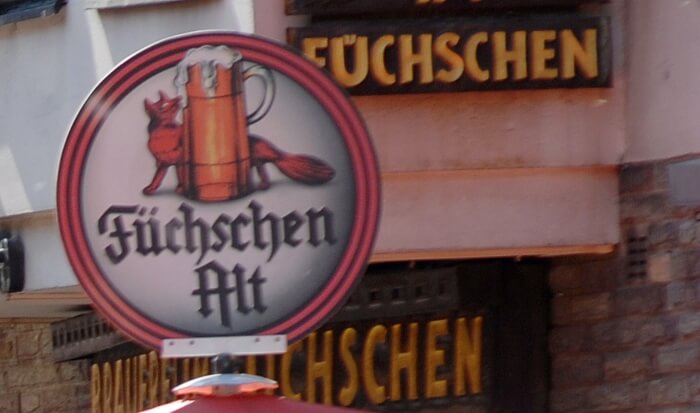
The Brauerei Fuchschen
I thought the waiter was just bringing us another beer, but there was far more to it than that. For a start, he wasn’t the waiter he was the Köbes, a name that derives from St Jacobus, known in English as St James of Santiago de Compostela. The name is a nod to the taverns that existed to provide food and drink to the pilgrims making the trek to the town of Santiago de Compostela in northwest Spain.
I learn this from Dietmar Schönhoff, my amiable and information-packed guide on a tour of the house breweries of Düsseldorf in northern Germany. They’re akin to what we might call brewpubs, and there are five remaining, all in the old town.
 ‘In 1870,’ Dietmar tells me, ‘there were 75 house breweries in the old town, but today there are just five. Here you find mostly Düsseldorfers. You’ll see some visitors, of course, but it’s mostly locals.’
‘In 1870,’ Dietmar tells me, ‘there were 75 house breweries in the old town, but today there are just five. Here you find mostly Düsseldorfers. You’ll see some visitors, of course, but it’s mostly locals.’
It would be easy enough to find your way to the brewpubs yourself, of course, but book a tour with a knowledgeable guide like Dietmar and you not only get a friendly drinking companion who shares your interest in beer, you also get a barrel-full of information about brewing in Düsseldorf.
‘Brewing started here in about the year 1000,’ Dietmar says, ‘but they had no hops so they used things like myrtle, honey, herbs and caraway, to make the beer palatable. It was probably horrible stuff.’
There’s a special reason for beer-lovers to visit Düsseldorf, and that’s the city’s Altbier. It’s unique to the Westphalia region, and in particular to Düsseldorf, and the name simply means Old Beer.
It came about, if I got this right – and we had consumed a fair number of Altbiers by this time – because in 1873 the first cooling machine was invented, and it allowed brewers to make beer all year round. It also meant they could use a bottom fermentation method, instead of the traditional top fermentation. Bottom fermentation produces a clearer more lager-style beer, while top fermentation gives us a darker more ale-like brew. In Düsseldorf they stuck with the traditional method, and made what became known as Old Beer, Altbier.
The first brewery to use the name was Schumacher, which opened in 1838 and is still going strong, the oldest of the five surviving breweries. Dietmar was saving them till last. We’d started at the grandly-named Uerige Obergärige Hausbrauerei, perhaps because it would be impossible to say the name by the end of the evening. This maze of wood-panelled bars and lounges is as old-fashioned as they come and looks like it hasn’t changed much since it opened in 1862.
Here Dietmar explains the traditional method of ordering, which is basically that you don’t. As you get to the end of one glass, the waiter will automatically bring you another until you signal your surrender by placing your beer mat across the top of your glass. It’s also traditional to serve Altbier in smaller glasses than usual, holding 25cl. These disappear very quickly.
From here we went to Zum Schlüssel, where a little soaking up was done with black pudding with onions and rye bread, and a delicious main course of Rheinischer Sauerbraten. This is marinated beef in a raisin sauce, served with red cabbage, potato dumpling, sliced almonds and stewed apples, and proof that German food isn’t just stodge but can be subtle and tasty.
The Altbier crawl continued at Füchschen, the Little Fox, which opened in 1848, and two Altbiers later it’s on to the Brauerei Kürzer, which was packed and, at 4.8% ABV, its Altbier packed a little more punch than the others too
Finally to the granddaddy, Schumacher, where Dietmar explained the hierarchy of the ordering system. The Köbes is the man who makes sure you always have an Altbier in front of you.
‘Of course,’ says Dietmar, ‘like any waiter it’s in his interest to sell you as much as possible, which is one reason for the fact that he will continue to bring you new glasses automatically. But you should also watch the measure he serves you. If he short-serves you then he gets more glasses out of the amount of beer he’s bought, and though most locals would check to see that the glass was filled to the top, visitors might not notice.’
The Köbes, I discover, doesn’t just bring beers from the bar. He buys his beer in bulk from someone known as the Sapaas, so as Dietmar explained, the more glasses he gets out of his beer, the more money he makes. But the Sapaas isn’t the end of the chain. He’s the middle man, who buys his beer from the Baas (no translation necessary), and sells it on to several different Köbes. No doubt he also has his way of, well, maximising his profits.
It seemed a complicated system, but in all five of these historic house breweries, each packed with hundreds of drinkers, we never had to try to catch the waiter’s eye and could concentrate on the task at hand – having a good time.
More Information
The author’s brewery tour was arranged through Düsseldorf Marketing & Tourismus, who can provide full information about visiting Düsseldorf. However, their tours are only for groups and the media, but identical tours are available through Altbier Safari.
Photos
Photos (c) Düsseldorf Marketing & Tourismus.


